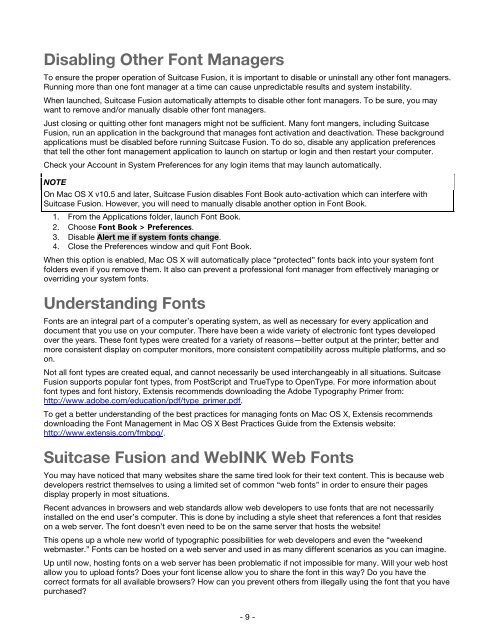Suitcase Fusion 3 User Guide for Mac OS - Extensis
Suitcase Fusion 3 User Guide for Mac OS - Extensis
Suitcase Fusion 3 User Guide for Mac OS - Extensis
Create successful ePaper yourself
Turn your PDF publications into a flip-book with our unique Google optimized e-Paper software.
Disabling Other Font Managers<br />
To ensure the proper operation of <strong>Suitcase</strong> <strong>Fusion</strong>, it is important to disable or uninstall any other font managers.<br />
Running more than one font manager at a time can cause unpredictable results and system instability.<br />
When launched, <strong>Suitcase</strong> <strong>Fusion</strong> automatically attempts to disable other font managers. To be sure, you may<br />
want to remove and/or manually disable other font managers.<br />
Just closing or quitting other font managers might not be sufficient. Many font mangers, including <strong>Suitcase</strong><br />
<strong>Fusion</strong>, run an application in the background that manages font activation and deactivation. These background<br />
applications must be disabled be<strong>for</strong>e running <strong>Suitcase</strong> <strong>Fusion</strong>. To do so, disable any application preferences<br />
that tell the other font management application to launch on startup or login and then restart your computer.<br />
Check your Account in System Preferences <strong>for</strong> any login items that may launch automatically.<br />
NOTE<br />
On <strong>Mac</strong> <strong>OS</strong> X v10.5 and later, <strong>Suitcase</strong> <strong>Fusion</strong> disables Font Book auto-activation which can interfere with<br />
<strong>Suitcase</strong> <strong>Fusion</strong>. However, you will need to manually disable another option in Font Book.<br />
1. From the Applications folder, launch Font Book.<br />
2. Choose Font Book > Preferences.<br />
3. Disable Alert me if system fonts change.<br />
4. Close the Preferences window and quit Font Book.<br />
When this option is enabled, <strong>Mac</strong> <strong>OS</strong> X will automatically place “protected” fonts back into your system font<br />
folders even if you remove them. It also can prevent a professional font manager from effectively managing or<br />
overriding your system fonts.<br />
Understanding Fonts<br />
Fonts are an integral part of a computer’s operating system, as well as necessary <strong>for</strong> every application and<br />
document that you use on your computer. There have been a wide variety of electronic font types developed<br />
over the years. These font types were created <strong>for</strong> a variety of reasons—better output at the printer; better and<br />
more consistent display on computer monitors, more consistent compatibility across multiple plat<strong>for</strong>ms, and so<br />
on.<br />
Not all font types are created equal, and cannot necessarily be used interchangeably in all situations. <strong>Suitcase</strong><br />
<strong>Fusion</strong> supports popular font types, from PostScript and TrueType to OpenType. For more in<strong>for</strong>mation about<br />
font types and font history, <strong>Extensis</strong> recommends downloading the Adobe Typography Primer from:<br />
http://www.adobe.com/education/pdf/type_primer.pdf.<br />
To get a better understanding of the best practices <strong>for</strong> managing fonts on <strong>Mac</strong> <strong>OS</strong> X, <strong>Extensis</strong> recommends<br />
downloading the Font Management in <strong>Mac</strong> <strong>OS</strong> X Best Practices <strong>Guide</strong> from the <strong>Extensis</strong> website:<br />
http://www.extensis.com/fmbpg/.<br />
<strong>Suitcase</strong> <strong>Fusion</strong> and WebINK Web Fonts<br />
You may have noticed that many websites share the same tired look <strong>for</strong> their text content. This is because web<br />
developers restrict themselves to using a limited set of common “web fonts” in order to ensure their pages<br />
display properly in most situations.<br />
Recent advances in browsers and web standards allow web developers to use fonts that are not necessarily<br />
installed on the end user’s computer. This is done by including a style sheet that references a font that resides<br />
on a web server. The font doesn’t even need to be on the same server that hosts the website!<br />
This opens up a whole new world of typographic possibilities <strong>for</strong> web developers and even the “weekend<br />
webmaster.” Fonts can be hosted on a web server and used in as many different scenarios as you can imagine.<br />
Up until now, hosting fonts on a web server has been problematic if not impossible <strong>for</strong> many. Will your web host<br />
allow you to upload fonts? Does your font license allow you to share the font in this way? Do you have the<br />
correct <strong>for</strong>mats <strong>for</strong> all available browsers? How can you prevent others from illegally using the font that you have<br />
purchased?<br />
- 9 -









